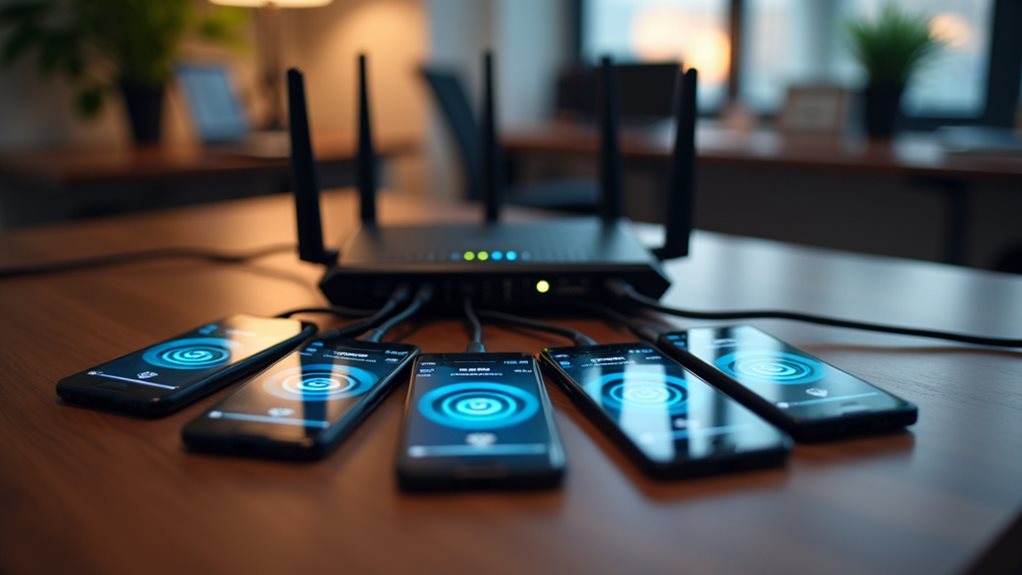If you’re prioritizing cost savings and seamless mobile integration, WiFi calling wins since it’s typically free with your existing cellular plan and uses your regular phone number. However, if you need advanced business features like call routing, conference capabilities, and superior international rates, VoIP is your better choice despite monthly fees ranging from $10-50. Both require stable internet connections around 100 kbps per call, but your specific communication needs will ultimately determine which technology serves you best.
Understanding VoIP Technology and How It Works
VoIP, or Voice over Internet Protocol, transforms your voice into digital data packets that travel across the internet rather than traditional phone lines. You’re fundamentally joining millions who’ve adopted this modern communication method that converts analog voice signals into digital format.
When you make a VoIP call, your device uses specific VoIP protocols like SIP (Session Initiation Protocol) to establish connections and manage call features. These protocols guarantee your voice data reaches its destination reliably and efficiently.
Your call quality depends heavily on bandwidth requirements, typically needing 64-100 kbps per call for peak performance. You’ll want a stable internet connection with sufficient upload and download speeds.
VoIP calls require 64-100 kbps bandwidth per connection, demanding stable internet with adequate upload and download speeds for optimal performance.
The process involves sampling snapshots of your analog voice signal, quantization to assign numerical values, and encoding to convert these values into digital data, with specialized codecs playing a crucial role in determining both call quality and bandwidth usage.
Unlike traditional telephony, VoIP utilizes your existing internet infrastructure, making it cost-effective and adaptable for both personal and business use across various devices and locations.
WiFi Calling Explained: Features and Functionality
Unlike VoIP services that require separate apps or systems, WiFi calling is a built-in feature that’s already integrated into most modern smartphones and mobile carriers’ networks.
You simply enable it through your phone’s settings, and it automatically switches between cellular and WiFi connections as needed.
WiFi advantages include crystal-clear call quality when you’re connected to strong internet, plus you’ll bypass cellular dead zones in your home or office.
You’re also using your existing phone number, so contacts won’t notice any difference.
However, WiFi limitations become apparent when your internet connection is unstable or slow, potentially causing dropped calls or poor audio quality.
The beauty lies in its seamless integration – you’re not learning new interfaces or managing separate accounts like traditional VoIP solutions.
One important consideration is that WiFi calling may have emergency services access limitations, as it doesn’t always connect to emergency services in the same way as traditional cellular calls.
Call Quality Comparison: Audio Clarity and Connection Stability

When it comes to audio clarity and connection stability, both technologies deliver impressive results under ideal conditions, but their performance varies considerably based on your specific setup.
VoIP typically provides superior audio quality when you’ve got a stable broadband connection, offering crystal-clear conversations with minimal distortion. However, you’ll notice that audio latency factors become more pronounced during peak internet usage hours or when your bandwidth is stretched thin.
WiFi calling generally maintains more consistent performance since it leverages your carrier’s network optimization, but you’re still dependent on your local WiFi strength.
Connection dropouts can plague both systems when network conditions deteriorate. You’ll find VoIP more susceptible to jitter and packet loss, while WiFi calling may experience sudden disconnections if your router struggles with signal coverage throughout your space.
To optimize either solution, implementing Quality of Service settings can help prioritize voice traffic and significantly reduce common issues like audio dropouts and connection instability.
Cost Analysis: Monthly Fees, International Rates, and Hidden Charges
Your wallet will feel the difference between VoIP and WiFi calling, especially when you’re making regular international calls or managing monthly service expenses.
VoIP services typically charge monthly subscription fees ranging from $10 to $50, while WiFi calling through your carrier might include international rates that can quickly add up on your phone bill.
You’ll want to compare these costs carefully, since international calling rates can vary dramatically—some VoIP providers offer unlimited international plans, whereas traditional carriers often charge per-minute rates that seem reasonable until you see your monthly statement.
For example, services like Ooma provide unlimited international calling to the USA, Mexico, and Canada with competitive rates for over 60 other countries, potentially offering significant savings compared to traditional carrier international charges.
Monthly Service Costs
Cost considerations often make or break your decision between VoIP and WiFi calling, especially when you’re looking at long-term expenses.
VoIP services typically require monthly pricing commitments ranging from $10-30 per user, depending on your chosen provider and features. You’ll find service plans vary greatly, with basic packages covering standard calling while premium options include video conferencing and advanced features.
WiFi calling, however, doesn’t demand separate monthly fees since it’s usually included with your existing cellular plan. You’re fundamentally using your current data allocation, making it cost-neutral for most users.
VoIP provides significant cost savings for businesses with high calling needs, particularly when making long-distance and international calls compared to traditional cellular service plans.
While VoIP offers more extensive business features, WiFi calling wins for budget-conscious individuals who want improved connectivity without additional monthly commitments. Your choice depends on whether you need advanced functionality or prefer simple, cost-effective communication.
International Calling Rates
International calling rates reveal stark differences between VoIP and WiFi calling that can greatly impact your wallet.
You’ll find VoIP services typically offer competitive international rates, often charging just pennies per minute to major destinations. Many providers bundle unlimited calling to specific countries, giving you predictable costs for staying connected globally.
WiFi calling, however, follows your carrier’s standard international rates, which can be considerably higher. You’re fundamentally making regular calls through your phone plan, just using WiFi instead of cellular towers.
The international call advantages lean heavily toward VoIP, where global calling options include flat-rate plans and discounted per-minute pricing. If you frequently call overseas, VoIP’s specialized international packages will likely save you considerable money compared to traditional carrier rates through WiFi calling.
VoIP services can provide savings of 50-75% on international calls compared to traditional phone services, making them an even more compelling choice for frequent international callers.
Device Compatibility and Setup Requirements

Device compatibility serves as the foundation that determines whether you can seamlessly integrate VoIP or WiFi calling into your daily communication routine.
You’ll find that WiFi calling typically requires minimal setup since it’s built into most modern smartphones. Simply enable the feature in your phone’s settings, and you’re connected through your existing carrier.
VoIP services demand more consideration regarding device compatibility. You’ll need to download specific apps or configure softphone software on your devices.
However, VoIP offers greater flexibility, working across smartphones, tablets, computers, and dedicated VoIP phones. The setup requirements vary by provider, but most offer user-friendly installation guides.
If you have existing analog phones, you can connect them to VoIP systems using Analog Telephone Adapters (ATA) for signal translation between your traditional equipment and internet-based communication.
Your choice depends on whether you prefer the simplicity of WiFi calling or VoIP’s versatile device support across multiple platforms.
Network Dependency and Internet Connection Needs
When examining network requirements, you’ll discover that both VoIP and WiFi calling depend entirely on your internet connection’s stability and speed. Understanding these dependencies helps you make informed decisions about which solution fits your communication needs.
Both technologies share similar network requirements, though they handle connections differently:
- Minimum bandwidth needs: VoIP typically requires 100 kbps per call, while WiFi calling needs similar speeds.
- Network reliability becomes essential: Dropped connections directly impact call quality and continuity.
- Data consumption varies: VoIP uses approximately 1 MB per minute, WiFi calling consumes slightly less.
- Backup connectivity matters: Having alternative internet sources prevents communication interruptions.
Your network’s consistency determines success with either option. Poor internet performance affects both technologies equally, causing choppy audio, delays, and dropped calls that’ll frustrate your daily communications.
Implementing proper network segmentation can enhance security and performance for both VoIP and WiFi calling systems by isolating voice traffic from other data on your network.
Security and Privacy Considerations

Security concerns differ considerably between VoIP and WiFi calling, affecting how your personal information and conversations stay protected.
VoIP services typically implement robust encryption methods, with many providers offering end-to-end encryption that scrambles your voice data during transmission. You’ll find that established VoIP companies invest heavily in security infrastructure, protecting your calls from potential eavesdropping.
WiFi calling, however, depends on your carrier’s security protocols and the WiFi network you’re using. When you’re connected to public WiFi, your data privacy becomes more vulnerable to interception. Your carrier usually encrypts WiFi calls, but the initial connection through unsecured networks creates potential weak points.
Both communication methods benefit from implementing multi-factor authentication to enhance security verification and prevent unauthorized access to your accounts.
You should consider using VPN services with either option for added protection, especially when making important calls containing sensitive information.
Business Vs Personal Use Cases
Everything changes when you’re choosing between VoIP and WiFi calling for your business versus personal needs, as each environment demands different features and reliability levels.
Your business applications require enterprise-grade features like call routing, conference capabilities, and integration with existing systems. VoIP typically wins here because it offers advanced management tools, scalability, and professional features that growing companies need.
For personal preferences, WiFi calling often takes the lead since it’s simpler and works seamlessly with your existing phone number and contacts.
Consider these key differences:
- Business needs: Advanced features, multi-user support, and professional call management
- Personal use: Simple setup, familiar interface, and basic calling functionality
- Cost considerations: Business VoIP plans versus free WiFi calling
- Technical support: Enterprise-level assistance versus carrier-based help
VoIP’s cost-effectiveness becomes particularly evident for businesses, with average monthly rates around $20 per user providing unlimited calls and eliminating expensive long-distance charges.
Making the Right Choice for Your Communication Needs

Your decision between VoIP and WiFi calling ultimately depends on matching the technology to your specific communication requirements and circumstances.
Consider your daily usage patterns, budget constraints, and technical preferences when evaluating options. A detailed feature comparison reveals that VoIP systems offer extensive business tools like call forwarding, voicemail-to-email, and conference capabilities, while WiFi calling provides seamless integration with your existing mobile service.
Your user experience will vary notably based on internet reliability and device compatibility.
If you’re running a business, VoIP’s advanced features and cost-effectiveness for multiple lines make it attractive. However, if you’re seeking simplicity and occasional use, WiFi calling’s straightforward setup appeals to many users.
Assess your network infrastructure, calling volume, and feature needs to determine which solution aligns with your communication goals.
Final Thoughts
You’ll find both VoIP and WiFi calling serve distinct purposes in today’s communication environment. If you’re running a business or need advanced features, VoIP typically offers better value and functionality. However, if you want seamless integration with your existing mobile service without extra costs, WiFi calling works perfectly. Consider your specific needs, budget, and usage patterns. The best choice depends on whether you prioritize feature-rich communication or simple, cost-effective connectivity.

